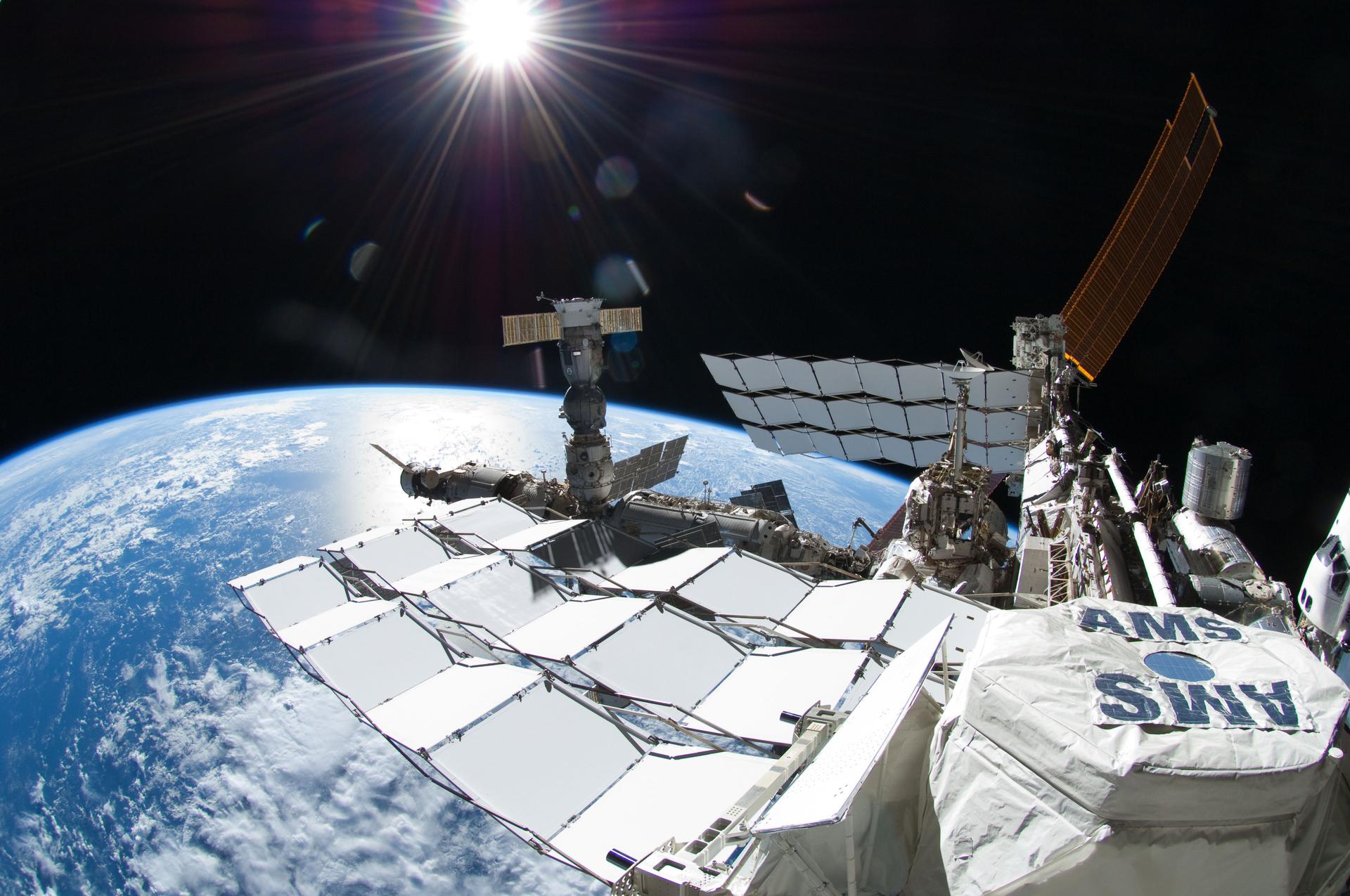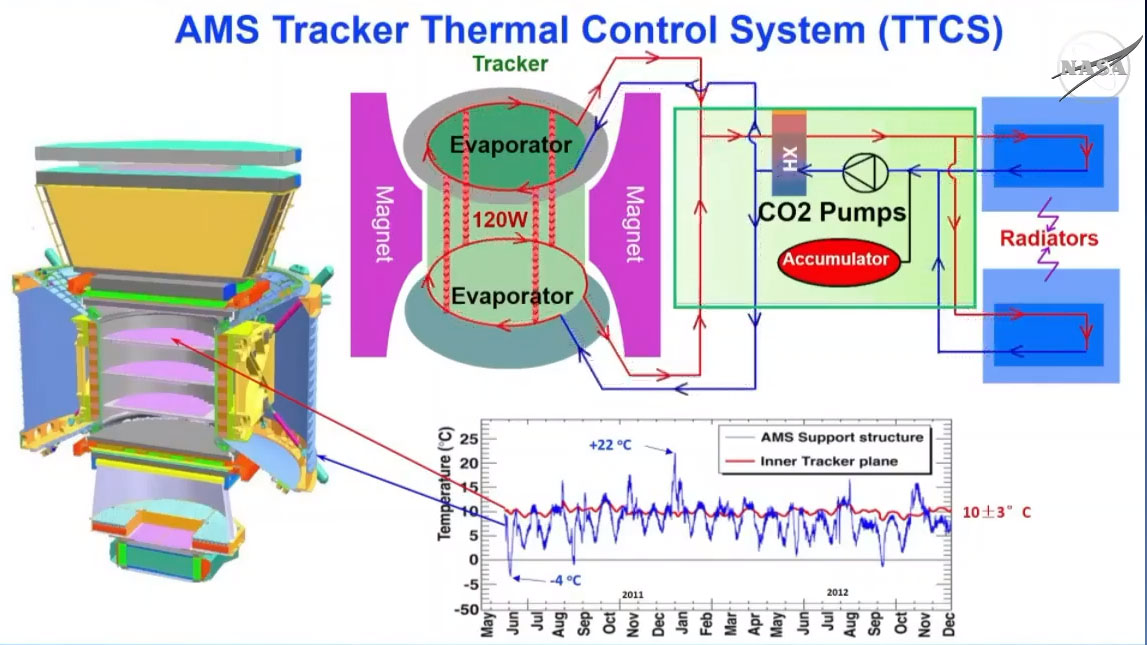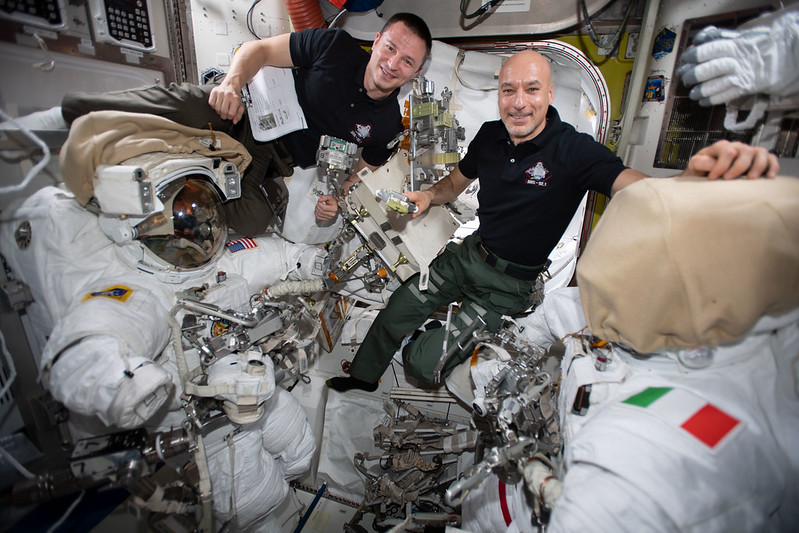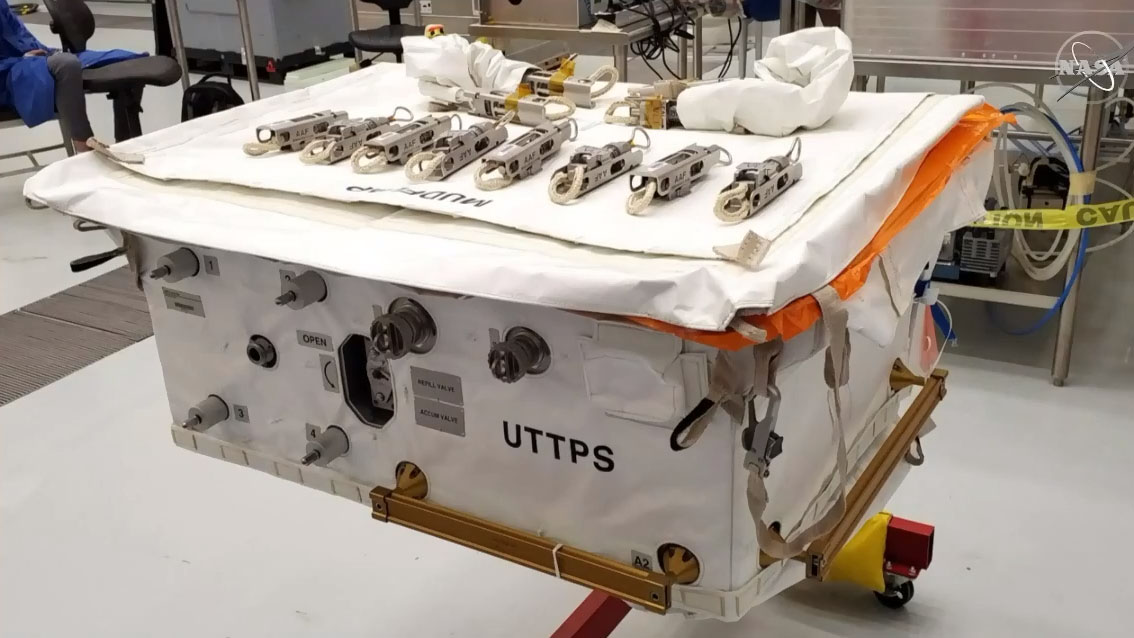Astronauts Will Take 4 of the Most Challenging Spacewalks Ever to Fix a Dark Matter Experiment

Two astronauts are gearing up for what may be the most challenging spacewalks in history.
NASA astronaut Andrew Morgan and Italian astronaut Luca Parmitano of the European Space Agency will take at least four spacewalks over the next few weeks to repair an ailing dark matter experiment outside the International Space Station. The spacewalk saga begins Friday morning (Nov. 15), when the duo will embark on the first 6.5-hour spacewalk. You can watch the spacewalk live here on Space.com, courtesy of NASA TV.
Called the Alpha Magnetic Spectrometer (AMS), the $2 billion experiment studies cosmic particles in space by using a huge, superconducting magnet to alter the particles' paths with its magnetic field. As the particles pass through this magnetic device, eight tiny particle detectors analyze their properties, looking for evidence of antimatter and dark matter.
Related: How the Antimatter-Hunting Alpha Magnetic Spectrometer Works (Infographic)
NASA launched the AMS to the International Space Station in 2011 on the space shuttle Endeavour, and the experiment was designed to have a lifetime of 10 to 18 years. However, just three years after it became operational, one of its four cooling pumps failed. The four pumps are redundant, with the AMS only using one at a time for periods of 3 to 4 months, so the experiment could continue despite the AMS being down a pump.
However, when a second pump failed just a few months later, "that was when we knew that we had a serious problem to deal with," Ken Bollweg, the AMS program manager, said in the news conference. "We knew we had to do something about it, especially since AMS was getting such compelling science," Bollweg said. "We knew we wanted to extend its life."
But AMS will be getting a lot more than just some new pumps. "It's not only replacing the pumps, it's replacing the accumulator, heat exchangers, heaters, valves — that whole pump package … will be attached to the outside of AMS," Bollweg said, adding that the spacewalkers will be working to connect new power and data cables as well.
Get the Space.com Newsletter
Breaking space news, the latest updates on rocket launches, skywatching events and more!

"It's a whole new package that's designed to extend the life [of AMS] until the end of the space station," Bollweg said. NASA is planning to end its space station operations in 2024, although Congress recently proposed an extension to 2030.
Not only will the astronauts be repairing the cooling system, but they're also going to upgrade it. "We'll actually improve the cooling significantly," Bollweg added. "As things are in space, with time they degrade [and] the optical properties change, so the cooling isn't quite as efficient. This is actually going to improve it to the point where we're expecting the cooling to be even better than it was when we first started."
Astronauts began preparing the AMS for the repair job in 2017, when NASA astronauts Peggy Whitson and Jack Fischer installed a new data cable during a spacewalk together. This cable would feed data from the AMS cooling system to engineers who were planning the experiment's complicated repair work back on Earth.

Because the AMS experiment was not designed to be repaired by astronauts in space, Friday's spacewalk will be particularly challenging, and the astronauts will have to take at least four 6.5-hour spacewalks to get the job done. In a news conference Tuesday (Nov. 12), Tara Jochim, NASA's AMS spacewalk repair project manager, said that in terms of difficulty, the AMS spacewalks are "definitely towards the top of the list, if not on the top."
The European Space Agency called these spacewalks the "most challenging since work to repair the Hubble Space Telescope." However, one big difference between the Hubble spacewalks and these AMS spacewalks is that the Hubble Space Telescope was designed to be serviced by astronauts in orbit. When NASA built the AMS, the agency was not planning to have astronauts touch it again once it was in space — and the bulky gloves that astronauts wear during spacewalks will surely add to the challenge.
"We're going to go in and actually bypass the cooling system that's on AMS. To do that you've got to cut into these small stainless steel tubes that are on AMS. That presents its own unique challenges," particularly when it comes to keeping the astronauts safe, Jochim said. "To do that you're creating sharp edges, and when you're inside of a large balloon yourself, you don't want to come up against sharp things, so we had to figure out how to safely go off and do that activity."

While this repair job will be an arduous task for the astronauts, it has also been a tremendous challenge for NASA's ground teams to plan. "We usually have a standard set of EVA [extravehicular activity] tools that we design all of our space equipment to be able to interface with," Jochim said. "Unfortunately not all those would work with this activity, so we designed about 25 new space tools that we flew on a variety of missions this year" to be able to conduct this repair, she added. The most recent batch of AMS equipment just arrived at the space station two weeks ago on a Cygnus cargo spacecraft.
After Friday's spacewalk, NASA is planning to send both Parmitano and Morgan out for a second spacewalk on Nov. 22. The third will take place around Dec. 1-2, and the date for the fourth spacewalk has yet to be determined, Kenny Todd, NASA's space station operations integration manager, said in the news conference. Depending on how smoothly these four spacewalks go, they may have to take additional spacewalks.
- In Pictures: The Most Memorable Spacewalks in History
- Antimatter-Hunting AMS Experiment in Space (Photos)
- A Space Magnet, Hunting Dark Matter, Turns Up Juicy Secrets of Cosmic Rays
Email Hanneke Weitering at hweitering@space.com or follow her @hannekescience. Follow us on Twitter @Spacedotcom and on Facebook.

Join our Space Forums to keep talking space on the latest missions, night sky and more! And if you have a news tip, correction or comment, let us know at: community@space.com.

Hanneke Weitering is a multimedia journalist in the Pacific Northwest reporting on the future of aviation at FutureFlight.aero and Aviation International News and was previously the Editor for Spaceflight and Astronomy news here at Space.com. As an editor with over 10 years of experience in science journalism she has previously written for Scholastic Classroom Magazines, MedPage Today and The Joint Institute for Computational Sciences at Oak Ridge National Laboratory. After studying physics at the University of Tennessee in her hometown of Knoxville, she earned her graduate degree in Science, Health and Environmental Reporting (SHERP) from New York University. Hanneke joined the Space.com team in 2016 as a staff writer and producer, covering topics including spaceflight and astronomy. She currently lives in Seattle, home of the Space Needle, with her cat and two snakes. In her spare time, Hanneke enjoys exploring the Rocky Mountains, basking in nature and looking for dark skies to gaze at the cosmos.









